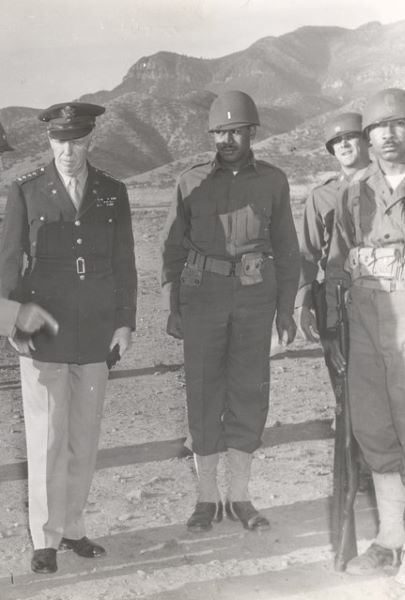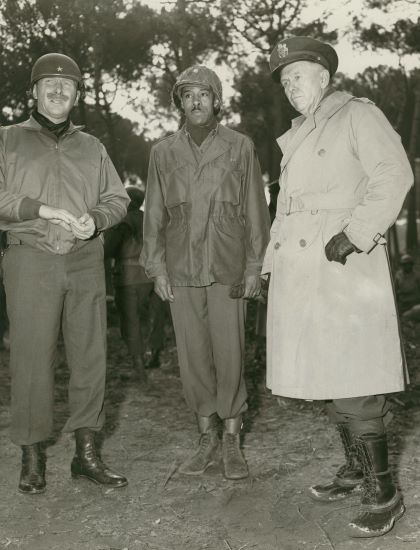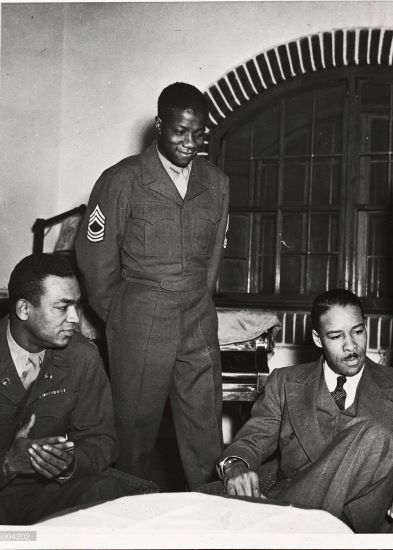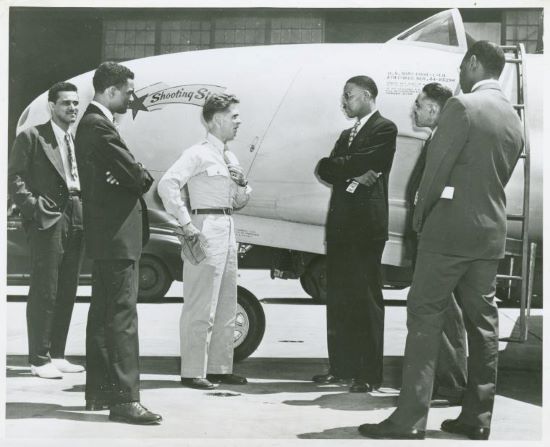Marcus Hannan Ray was born in Chicago to Randall and Ada Ray in 1904. Randall was a porter for the railroad, and had moved his family to Chicago shortly before Marcus was born; they had previously lived in New Orleans, Louisiana.
Ray graduated from the University of Illinois and soon after enlisted in the Illinois National Guard as a private. He was commissioned a lieutenant in 1929 and served in the 8th Infantry (Colored), which later became the 370th Infantry Regiment. In his civilian life, he worked at the Post Office in Chicago.
Ray and another local officer were assigned to the Army Infantry School National Guard Officer’s Course in 1931, where he first became acquainted with George Marshall, assistant commandant in charge of academics at the school. Marshall was in his last year of service at the school when the two African-American National Guard officers arrived from Illinois. Marshall squashed the objections of certain classmates to the two officers attending classes, and Ray and his Illinois classmate graduated from the school at the end of the summer.
As Ray wrote to Marshall later, “We were told of the petition circulated by officers of our class who objected to the presence of two Negroes. Also we were told of your decision and handling of the situation. Throughout my career your quiet and courageous firmness, in this case, has served to hold my belief in the eventual solution of the problems.”
In 1934, Marcus married Adine DuLuc, a schoolteacher. They had a daughter in 1940, about the same time his National Guard unit was federalized. By 1943, Lt. Col. Marcus Ray was battalion commander of the 600th Field Artillery, the 155 mm howitzers for the 92nd Division, and they were training at Fort Huachuca, AZ, for overseas deployment. Marshall visited the unit as he traveled extensively, ensuring units were getting properly trained before deployment.

Lt. Col Marcus Ray with Gen. George C. Marshall at Fort Huachuca. Ray was still wearing his National Guard uniform and helmet, issued when he was a lieutenant. The unit had not yet received the uniforms they would take overseas.
In 1944, the battalion served in the Italian campaign during one of the coldest winters on record in Europe. In February 1944, during the campaign, Gen. Marshall again visited Ray at his unit, and witnessed the firing of Ray’s 155 mm howitzer batteries.

Brig. Gen. William Colburn, Lt. Col. Marcus Ray, and Gen. George Marshall in Italy, February 1944.
Later Ray wrote of men in his unit, “Therefore, I feel that those who performed in a superior manner and those who died in the proper performance of their assigned duties are our men of the decade and all honor should be paid them. They were Americans before all else.”
The battalion was deactivated in 1945, and Lt. Col. Ray demobilized. For his service, he was awarded the Legion of Merit, a bronze star, and the Italian Cross for Merit of War.
Just a few weeks later, Ray went to work as a special aide to Secretary of War Patterson as a liaison for race relations in the U.S. Army. He traveled widely and reported on the difficulties and successes around the world.
Ray traveled throughout Europe inspecting soldiers at work, and gauging their morale and discipline. He looked at housing and recreation areas. He also examined race relations and community attitudes at the various bases.

Marcus Ray visiting with soldiers in Germany as part of his inspection tour.
In July 1946, Ray visited Wright Field, OH, for an inspection. He found 21,000 workers of various races working peacefully together, and this gave him hope. “I would rate this installation as the best example of efficient utilization of manpower I have seen. The integration has been accomplished without publicity and simply by assigning workers according to their capabilities and without regard to race, creed, or color.”

Marcus Ray, right in sunglasses, at Wright Field in July 1946, as special aide to Secretary of War Patterson.
In 1947, Ray re-entered the Army, and served as a chief aide to Military Governor of Germany, Gen. Lucius Clay, as the Army prepared for desegregation. His wife, daughter, and son lived in Germany for several years during this time.
When George Marshall was awarded the Nobel Peace Prize in 1953, Col. Ray wrote to him from Central State College in Wilberforce, OH, where he was working with the ROTC program.
“May I extend my sincere and heartfelt congratulations to you on the occasion of your selection for the Nobel Peace Award. It is fitting international recognition of the man, who more than any other living American represents the honor, integrity and selfless devotion … of this great nation.”
Col. Ray retired from the Army in 1958 and went to work for the Office of the Army Adjutant General in Chicago until he retired again in 1966. Ray and his wife, Adine, lived in Switzerland and traveled in Europe for several years. They returned to the United States in 1976, settling in the Washington, D.C., area to be close to their grandchildren. Ray died in 1988 and is buried in Arlington Cemetery.
Information and photos from the George C. Marshall Foundation, 8thinfantry.org, Integration of the Armed Forces 1940-1965 by Morris MacGregor, Jr., and the United States Census.
Melissa has been at GCMF since Fall 2019, and previously was an academic librarian specializing in history. She and her husband, John, have three grown children, and live in Rockbridge County with three large rescue dogs. Keep up with her @life_melissas.
